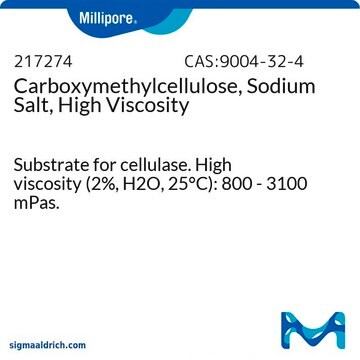C5013
Carboxymethylcellulose sodium salt
High viscosity
Sinonimo/i:
Sodium carboxymethylcellulose
About This Item
Prodotti consigliati
Origine biologica
wood (pulp)
Forma fisica
powder
Colore
light yellow
Intervallo di pH utile
(20 °C, 10 g/L, 68 °F neutral)
Viscosità
1500-3000 cP, 1 % in H2O(25 °C)(lit.)
Punto di fusione
> 300.05 °C ((> 572.09 °F ))
Solubilità
H2O: 10 mg/mL
Cationi in tracce
Na: 6.5-9.5%
Temperatura di conservazione
room temp
InChI
1S/C6H12O6.C2H4O2.Na/c7-1-3(9)5(11)6(12)4(10)2-8;1-2(3)4;/h1,3-6,8-12H,2H2;1H3,(H,3,4);
DPXJVFZANSGRMM-UHFFFAOYSA-N
Cerchi prodotti simili? Visita Guida al confronto tra prodotti
Descrizione generale
Applicazioni
Nota sulla preparazione
Altre note
Codice della classe di stoccaggio
11 - Combustible Solids
Classe di pericolosità dell'acqua (WGK)
WGK 1
Punto d’infiammabilità (°F)
Not applicable
Punto d’infiammabilità (°C)
Not applicable
Dispositivi di protezione individuale
Eyeshields, Gloves, type N95 (US)
Certificati d'analisi (COA)
Cerca il Certificati d'analisi (COA) digitando il numero di lotto/batch corrispondente. I numeri di lotto o di batch sono stampati sull'etichetta dei prodotti dopo la parola ‘Lotto’ o ‘Batch’.
Possiedi già questo prodotto?
I documenti relativi ai prodotti acquistati recentemente sono disponibili nell’Archivio dei documenti.
I clienti hanno visto anche
Il team dei nostri ricercatori vanta grande esperienza in tutte le aree della ricerca quali Life Science, scienza dei materiali, sintesi chimica, cromatografia, discipline analitiche, ecc..
Contatta l'Assistenza Tecnica.

